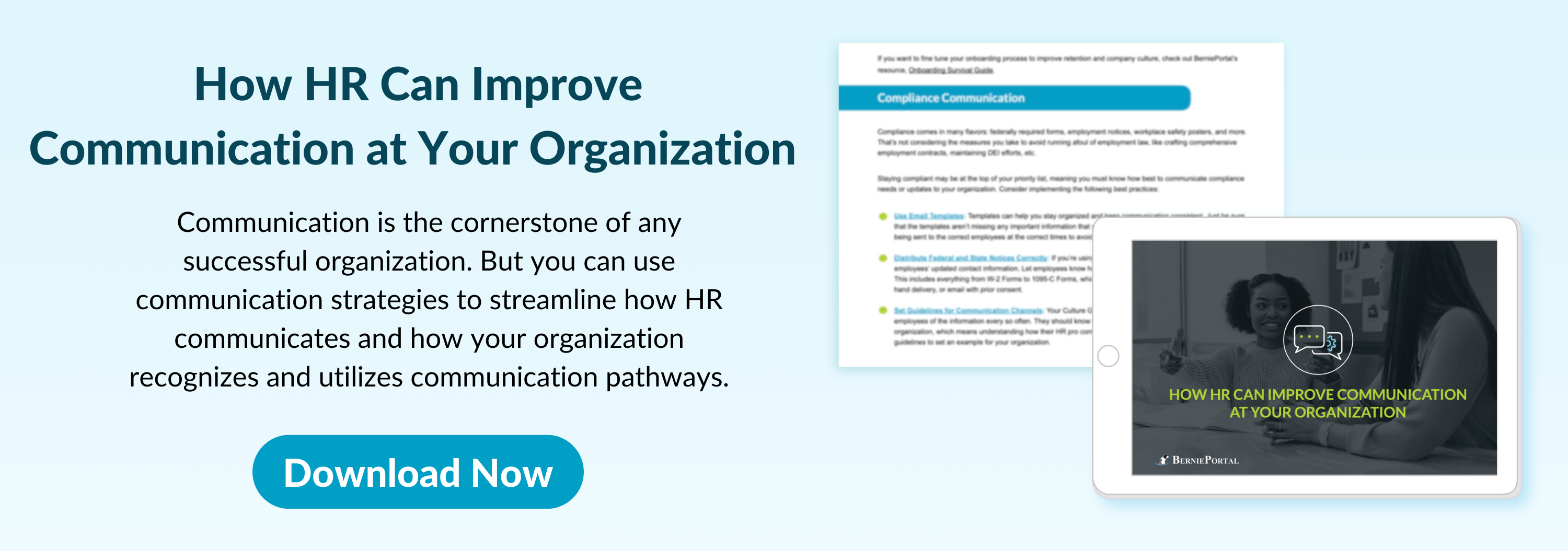Written by
Will Miranne
Will is an aPHR-certified writer on the marketing team at BerniePortal. He writes about healthcare, human resources, and benefits.
HR Guide: Understanding The Levels Document

Levels documents play an important role in organizations' pay transparency efforts. They help determine the basis of job responsibilities, necessary skills, and salary expectations for each role. Correct implementation of a levels document can lead to a more transparent organization and improve the employee experience.
Read on to learn more about levels documents, what they consist of, and how you can effectively craft one for your organization.
What Is a Levels document?
Levels documents are a combination of 3 distinct documents:
-
Scope
-
Skill
-
Salary
Scope determines what the team member is actually going to be working on. At the start, they may have little interaction with people outside of their team. They may also be tied to projects they have already proven to be successful with in the past. An increase in scope involves moving into activities and projects that push the boundaries of their basic role and impact organizational success in new ways. Thus the scope document is primarily used to evaluate an employee's performance and identify areas for improvement. Scope can also be used to set goals and expectations for employees, which can boost overall motivation and enhance job satisfaction.
A competency or skills-level document outlines the skills and abilities required for success in a specific job. It can include technical skills and soft skills. A skills-level document can also be used for employee training and development. By clearly defining the skills needed for a particular job, employees can better understand what is expected of them and how they can improve their skills.
A salary-level document outlines the differing pay ranges and criteria for determining an employee's salary. It can include education, experience, job performance, and market conditions. A salary-level document can ensure that employees are paid fairly and consistently based on their qualifications and contributions to the company. By providing transparency around salary levels, employees can better understand how their pay is determined and what they need to do to advance their careers within the company.
While each type of level document serves a different purpose, they can be used together to provide a comprehensive understanding of job expectations, skills requirements, and compensation.
How to Combine Levels Documents into One Single Document
Organizations will want to combine scope, competency, and salary levels documents into a single document to provide a more comprehensive expectation and overview of differing job expectations, skills requirements, and compensation. Here are some steps you can take to create a single holistic levels document:
-
Establish a clear outline. This should include an introduction providing an overview of the document, followed by individual sections on performance expectations, competency requirements, salary levels, and criteria.
-
Determine the performance expectations and criteria that are relevant to each job role. This should include productivity, quality, teamwork, communication, and other key factors that are important to job success. Be sure to clearly outline the expectations for each criterion, as well as how performance will be evaluated.
-
Identify the essential skills required for success in each job role. This may include technical skills, soft skills, and other competencies that are relevant to the job. Be sure to clearly outline the required competencies and how they will be evaluated and developed.
-
Establish salary levels and criteria that are fair and consistent across the organization. This may include factors such as education, experience, performance, and market conditions. Clearly outline the salary levels and criteria for each role and how they will be reviewed and adjusted over time.
-
Form several tables visually expressing the skill requirements, salary, and performance expectations.
By combining performance, competency, and salary levels documents, employers can provide a more comprehensive understanding of job expectations and what is needed to progress. This can improve communication and collaboration among team members, increase employee motivation, and ensure all pay practices are entirely transparent across the organization.
What Are the Benefits of Using a Levels Document?
There are several benefits to using levels documents in the workplace, including improved communication, increased understanding of job expectations, clear criteria for performance evaluations and promotions, increased employee motivation and job satisfaction, and fair and consistent pay practices.
Levels documents can provide a clear and concise understanding of job expectations, which can help employees to prioritize their tasks and focus on those that are the most pivotal. This can lead to improved communication and collaboration among team members, as well as increased job satisfaction, as employees feel more confident in their ability to perform their job duties.
By establishing specific performance expectations and competencies, employees can better understand what is expected of them and how they can improve their skills to advance their careers within the company. This can also help to ensure that performance evaluations are fair and consistent.
Finally, levels documents can help to ensure fair and consistent pay practices. By establishing clear salary levels and promotion criteria, employers can ensure that employees are being paid fairly based on their qualifications, experience, and performance. This can also help to increase employee motivation and job satisfaction, as employees feel more recognized by their organization for their achievements.
Overall, levels documents can be a valuable tool for employers looking to improve communication, establish clear expectations, and ensure transparent pay strategies.
How to Craft an Effective Levels document
Crafting an effective levels document requires careful planning and attention to detail. Here are several steps to consider when creating a levels document:
-
Firstly, identify the key job roles within the organization and establish a clear hierarchy of positions. You will need to craft different levels documents for each position within the organization. This will account for the varying roles and responsibilities within the organization.
-
Next, establish clear performance expectations and criteria for each job role. This may include factors such as productivity, quality, teamwork, communication, and other key factors that are important to job success. It may also include the scope of the role, such as the variance in projects they are a part of. If they work with several different teams, they may have a more extensive scope than employees who work solely within their team's framework. Be sure to clearly outline the expectations for each criterion, as well as how performance will be evaluated and measured.
-
Then, identify the key competencies required for success in each job role. This may include technical skills, certifications, internal and external training, conferences, courses taken, and even general knowledge acquired. Be sure to clearly outline all skill-increasing opportunities and how they will be verified.
-
Finally, establish salary levels that reflect the market values and your desire to maintain fair and transparent pay strategies. This decision can impact factors such as education, experience, performance, and market conditions. Salary levels may need to be revisited regularly to ensure wages are current with market conditions and inflation. Be sure to clearly outline the salary levels and criteria for each job role and how they will be reviewed and adjusted down the line.
When crafting an effective levels document, it's important to ensure that all relevant stakeholders, including the C-suite, managers, and HR professionals, are involved in the process. This can help ensure that the document is comprehensive, accounts for all factors, remains accurate, and reflects the needs and expectations of the organization.
Additional Resources
You can also stay informed, educated, and up-to-date with all things HR by using BerniePortal’s comprehensive resources:
-
BernieU—free online HR courses, approved for SHRM and HRCI recertification credit
-
BerniePortal Blog—a one-stop-shop for HR industry news
-
HR Glossary—featuring the most common HR terms, acronyms, and compliance
-
HR Guides—essential pillars covering an extensive list of comprehensive HR topics
-
HR Party of One—our popular YouTube series and podcast, covering emerging HR trends and enduring HR topics
Written by
Will Miranne
Will is an aPHR-certified writer on the marketing team at BerniePortal. He writes about healthcare, human resources, and benefits.
Related Posts
Recent years saw a rapid increase in workplace perk offerings. The goal was to entice...
Skip-level meetings are a nontraditional way for organizations to garner additional...
An HRIS can revolutionize your HR position, but what is an HRIS? A human resources...






.jpg)

Submit a Comment